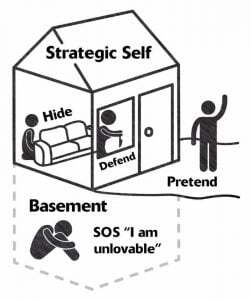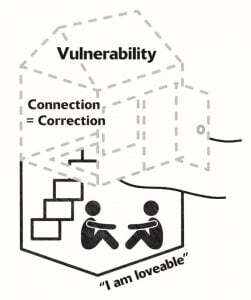Note: this post is a continuation from Happiness is a By-Product, Not a Goal – Part 1. If you haven’t read that yet, please start there.
We develop this basement early in life. We operate primarily from our emotions all through our childhoods. Our thinking brain, or neocortex, starts to kick in at around age five (usually when sequential memory begins) and isn’t fully developed until early adulthood. As children, we are emotional beings driven by connection first and thinking beings able to sort facts and understand nuances second. Connection continues to be vitally important throughout our lives, despite most adults preferring to insulate themselves from this reality by dulling their feelings.
We are born into a family system, often to well-intentioned and imperfect parents who were raised by well-intentioned and imperfect parents. At some point in time, something painful happens, often with the people who love us, and this “happening” lays the foundation for all the difficulties we end up having in relationships with others. Sometimes something overtly traumatic happens, like being hit, yelled at, or abused in some way. Sometimes something covertly traumatic happens, typically when part of our being is invalidated or ignored.
Whenever a child is faced with a perceived choice to be who they are or maintain the bond with an important other (by maintaining their love and approval), they will always choose to sacrifice self to maintain the bond because it is experienced as a survival-based choice. “I am not allowed to be angry, it is bad to be angry, I am bad…” In this way we sentence part of ourselves to the basement, to be hidden and locked away.
What happens in this moment of terror is that we literally start to feel that who we are is flawed, not good enough, unlovable. In those moments, we are flooded with fear and shame, and we think, oh no…what have I done? We experience fear, guilt, and shame, and believe we must be bad, wrong, flawed, unworthy, and variations on that theme. We take on what we call a “suspicion of self,” SOS for short. Though we seem here to be describing a thought, this suspicion of self is actually more of a feeling (shame) that hides a thought (“not good enough”).
This is important to understand, because it is the feeling we put in the basement, and in these painful moments we learn to separate thinking from feeling. We have a certain intellectual understanding of who we are and how we operate, which differs from how we feel. This is the dilemma facing most adults: we know better intellectually (after all, we have our “shelf help” section at home to refer to), and what we know doesn’t match how we feel. We end up in a constant inner argument between what we know to be true and how we feel, trying to talk ourselves out of our feelings.
We develop a strategic self, initially a mask on the porch to our house, in order to cover up what we fear about ourselves in the basement of our psyches. This strategic self replaces who we fear we are (SOS) with who we have surmised we need to be (mask) in order be viewed as an acceptable person. We fear that we are flawed, when in reality we are anything but. We hide, pretend and defend.
Carl Rogers said, “The curious paradox is that when I accept myself as I am, then I can change.” Rather than hide our fears (SOSs) by locking them away in the basement and donning a strategic personality, we have to turn back to the basement and let ourselves be vulnerable where we are vulnerable. The basement is only a basement because we are hiding our fears. Hiding and or defending produces more of the shame and guilt we are trying to alleviate. Without masks or defenses, our fears become simple human vulnerability.
Vulnerability is connective. Brené Brown has written extensively and beautifully on this, and we have seen the truth of that over and over again in our personal and professional lives. When someone is legitimately vulnerable, our hearts open. We care. That caring extends itself to the person in front of us, and a connection is formed.
Because our suspicions of self were made up in relationships, they must be corrected there as well (meaning in connection with another human being). We can read all the self-help books we like and understand the intricacies of how we operate, but without connection, that will leave us in a constant argument between what we know to be true and what we feel. We will be split, knowing better in our head but feeling something different emotionally. We will constantly be trying to talk ourselves out of our feelings.
The feeling of connection is the correction for these suspicions of self. Not so much the affirmation, the “you are good enough,” loveable, or whatever, although these words spoken by another human being (or oneself) are a helpful anchor. The aspect of self we sentenced to the basement has been disconnected, suffering in isolation. The feeling of connection pulls us out of the basement and back into life.
The quality of our life experience shifts dramatically when we make connection our goal, on a psychological, emotional, and spiritual level. We move from pursuing the narrow feeling of “happiness” on the emotional spectrum to experiencing what it means to be fully alive and fully human. We may not be happy all the time, but life has a strong pulse and is rich. Within the context of connection, we discover that we can be who we are, flaws and all. Our ability to meet, accept, and embrace our flaws is what will save our relationships, as opposed to ruin them. We experience the rainbow of human emotion, rather than just pursuing a narrow sliver of it. There is nothing to fear, because we belong and are good enough as we are.
We are here to be ourselves, to be authentic, loving, vulnerable, brave, and honest. At the end of the day, love is all that matters, and to experience love, we have to risk being real.

Catherine and Duane O’Kane are the founders of Clearmind international. It is Duane’s passion and belief that all that we strive for is held hostage in the middle of every moment, every relationship and every situation. Clearmind was birthed from these principles and continues to evolve. If you ask Catherine how Clearmind began, she says our mission statement “Love out Loud” sums it all up. Anyone can feel wonderfully inspired, but if it isn’t acted upon, it doesn’t have a life.



